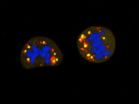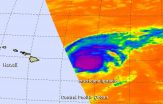INFORMATION:
Epigenomic changes are key to innate immunological memory
2015-08-31
(Press-News.org) It was long believed that acquired immunity--a type of immunity mediated by T- and B-cells--had memory, meaning that it could learn from new pathogens, making subsequent reactions more effective, whereas innate immunity--which is mediated by macrophages and other types of cells that react to certain molecules typically associated with pathogens--did not. However, it gradually became clear that things were not so simple. Plants and insects, which only have innate immunity, also seem to have immunological memory. Further, it has been reported that herpes virus infection increases the resistance against bacteria in vertebrates. These phenomena suggest that innate immunity also has memory, but researchers have been reluctant to accept the hypothesis given the lack of a mechanism Now, in research published in Nature Immunology, a research team led by Keisuke Yoshida and Shunsuke Ishii of the RIKEN Molecular Genetics Laboratory has revealed that epigenomic changes induced by pathogen infections, mediated by a transcription factor called ATF7, are the underlying mechanism of the memory of innate immunity.
The research began from the discovery that in ATF7 knockout mice, macrophages appear similar to wild-type macrophages that have been activated by exposure to molecules that occur commonly in infections. The group had previously reported that ATF7-related transcription factors mediated epigenomic changes induced by heat shock or psychological stress, and that these changes were maintained for long periods after the exposure to the stress. Therefore, they speculated that infections by pathogens could induce epigenome changes in macrophages via ATF7.
The group discovered that ATF7 binds to a group of innate immune genes and by doing so silences their expression, making the cell less responsive to infections. However, upon administration of lipopolysaccharidel (LPS), a molecule found in the outer membrane of Gram-negative bacteria, into mice, ATF7 was phosphorylated, weakening its activity so that immune-related genes were no longer silenced. Shunsuke Ishii, who led the group, says, "We were intrigued to find that even three weeks after the administration, the genes still showed increased activation. In mice, this status was shown to lead to increased resistance to Staphylococcus aureus, a Gram-positive bacteria."
According to Ishii, this finding could increase our understanding of what is known as the "hygiene hypothesis"--the concept that pathogen infection and unhygienic environment during infancy reduces the risk of allergy later in life. This hypothesis has been put forward to explain why the incidence of allergies and asthma is increasing around the world despite better hygienic conditions. "Though many researchers believe the hypothesis," says Ishii, "there is great uncertainty about how pathogen infection is memorized until adulthood. Since our research demonstrates that the pathogen-induced epigenomic changes mediated by ATF7 are maintained for a long period, this provides a plausible explanation of how the changes are induced. It also means that the genes that are affected can be used for the diagnosis of allergy."
Another possible application of these findings is for the choice of adjuvants in vaccines. Adjuvants--the name used for substances that activate innate immunity--are a necessary ingredient of efficient vaccines. The effect of adjuvant has generally been thought to end within a few days, but the present research showed that its effect can be maintained for longer periods. Says Ishii, "These results could affect the selection method of adjuvants, and we hope that they will contribute to the development of more efficient vaccines."
ELSE PRESS RELEASES FROM THIS DATE:
'Eat me' signal whets appetites for tumor-devouring dendritic cells
2015-08-31
By changing the mouse model they use to study how the immune system responds to cancer, a team of researchers hopes to shift the focus for one emerging form of cancer immunotherapy back to the standard approach--relying on antigen-presenting dendritic cells--and away from the current upstart, macrophages.
Although macrophages, like dendritic cells, also take up antigens, they are more likely to degrade them than present them to T cells. The recent emphasis on macrophages stems, in part, from promising, but problematic, efforts to develop an effective macrophage-driven ...
CNIO scientists propose attacking bioenergetic metabolism to improve anti-cancer therapies
2015-08-31
Cancer cells become addicted to glucose, which they use as their regular source of energy to grow and develop. Although this was observed over nine decades ago by the German physiologist, Otto Warburg; there is still not therapeutic strategy today that can effectively take advantage of this special energy requirement. The initial approach appears to be simple: the lack of glucose could specifically induce the death of cancer cells.
A new study by the Spanish National Cancer Research Centre Cell and Cancer Unit, headed by the Cell Division and Cancer group of the Spanish ...
DNA-guided 3-D printing of human tissue is unveiled
2015-08-31
A UCSF-led team has developed a technique to build tiny models of human tissues, called organoids, more precisely than ever before using a process that turns human cells into a biological equivalent of LEGO bricks. These mini-tissues in a dish can be used to study how particular structural features of tissue affect normal growth or go awry in cancer. They could be used for therapeutic drug screening and to help teach researchers how to grow whole human organs.
The new technique -- called DNA Programmed Assembly of Cells (DPAC) and reported in the journal Nature Methods ...
Closer to a treatment for the 'asthma of the esophagus'
2015-08-31
Scientists from the D'Or Institute of Research and Education (IDOR), the Federal University of Rio de Janeiro (UFRJ) and the Yale University School of Medicine have elucidated the chemical process behind a mysterious gastrointestinal disease that is becoming more frequent every day: the eosinophilic esophagitis (EoE), also known as the "asthma of the esophagus". The researchers identified a molecule which plays a key role in this condition and that can be a target in a new therapeutic strategy.
The eosinophilic esophagitis is a chronic inflammatory disorder of the esophagus. ...
The 5-colour nutritional labelling system is the most effective for consumers
2015-08-31
While the French High Council for Public Health (HCSP) made public on Monday, 24 August 2015, a positive opinion regarding the relevance of the 5-colour code for the public, a team of researchers (Inserm/INRA/Paris 13 University) directed by Serge Hercberg, on publication of their article in the journal Nutrients, demonstrated that the 5-colour nutrition label (5-CNL) is the most effective nutritional information system for allowing consumers to recognise and compare the nutritional quality of foods, including "at-risk" populations (older subjects, those with a lower educational ...
Preventive medicine experts speak out about reducing firearm violence
2015-08-31
Amsterdam, NL, August 31, 2015 -- Every week in the U.S. an average of 645 people lose their lives to firearm violence and 1,565 more are treated in an emergency department for a firearm-related injury. Most of these events do not make headlines, but they account for about 7% of the premature deaths before age 65 in the U.S. In a special issue of Preventive Medicine, preventive medicine and health policy experts address a wide range of critical topics related to firearm violence, from the interaction of alcohol abuse with gun violence, effects of changes to gun laws in ...
Alzheimer's disease -- Overlooked for 30 years: A new kid on the block
2015-08-31
Alzheimer's disease is associated with the appearance of characteristic neurotoxic protein aggregates in various regions in the brain. Chemical analysis of these insoluble deposits reveals that they are made up of a family of short protein fragments, referred to as beta-amyloid peptides, which are derived from a precursor protein called APP by the sequential action of two enzymes. An international team of researchers led by Christian Haass (Professor of Metabolic Biochemistry at LMU and Speaker for the German Center for Neurodegenerative Diseases in Munich) and Dr. Michael ...
Mayo researchers examine risk factors/patient outcomes associated with colorectal cancer
2015-08-31
ROCHESTER, Minn. -- About 20 percent of colorectal cancer patients have cancers that have spread (metastasized) beyond the colon at the time of their diagnosis. The liver is the most common site for these metastases. The approach to treating primary tumors within the colon and metastatic tumors in the liver continues to evolve; however, it typically involves chemotherapy plus surgical removal (resection) of both types of tumors. However, experts continue to debate whether surgical resection of primary tumors and metastatic tumors should be performed at the same time (synchronously) ...
As wind-turbine farms expand, research shows they could offer diminishing returns
2015-08-31
LAWRENCE -- Renewable wind energy is experiencing a boom, with more wind turbines popping up across landscapes in the U.S. and abroad. Indeed, wind energy accounted for 3.3 percent of electricity generation in the United States in 2011, according to the U.S. Energy Information Administration. Globally, that number was 2.9 percent for the same year.
But as wind turbines proliferate, researchers at the University of Kansas are looking at how these forests of turbines affect the wind itself. What happens to the wind when a larger number of wind turbines removes more and ...
NASA sees a weakening Hurricane Ignacio moving parallel to Hawaiian Islands
2015-08-31
NASA's Aqua satellite passed over Hurricane Ignacio and viewed the storm in infrared light, providing valuable temperature data. Aqua saw a weaker Ignacio moving parallel to the Hawaiian Islands.
The Atmospheric Infrared Sounder or AIRS instrument aboard Aqua gathers infrared data that shows temperatures. That AIRS data was made into a false-colored infrared image from August 30 at 22:47 UTC (6:47 p.m. EDT) and showed high, cold, strong thunderstorms surrounded the center of Hurricane Ignacio.
AIRS imagery also showed a thick band of thunderstorms spiraling into the ...

